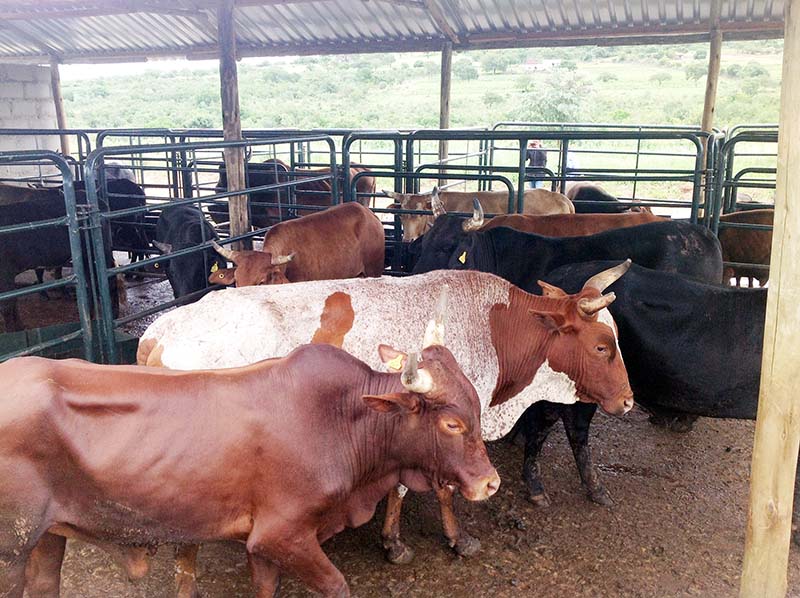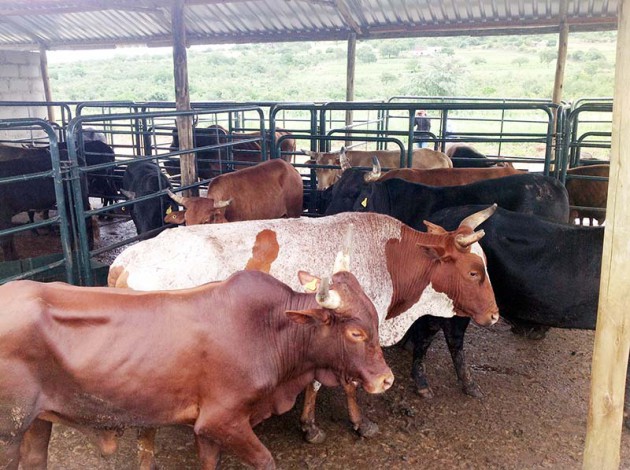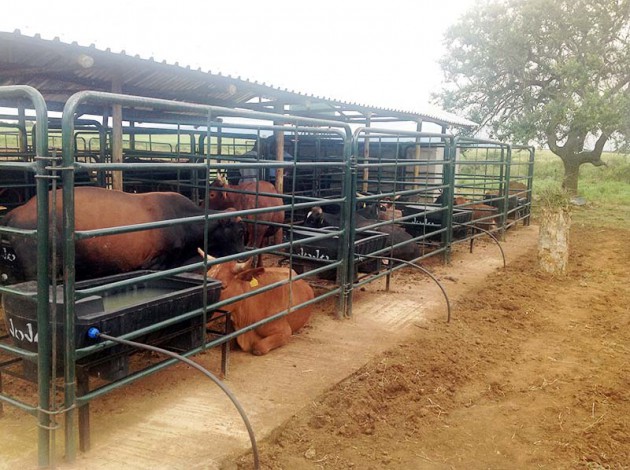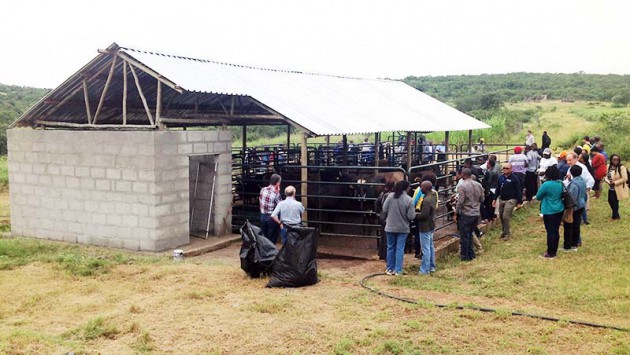Unlocking value of rural livestock


Cattle at the Komati Downstream Development Project Singeni Investment in Swaziland
Sydney Kawadza Senior Features Writer
Growing up in Chiware Village in Rusape, Manicaland province, vivid memories of tending to the family’s herd of cattle remain etched in the mind. Cattle are an integral part of every household, not only in Zimbabwe, but Africa as a whole.
The poignant memories of that herd with each beast carrying a specific name never die. In our herd were the oxen; Boxen, United and Point, as well as one particular cow called Shine.
Boxen (probably from Boxing) was popular for his huge stature and regular victories in cattle fights. United was infamous for goring the old grandfather who had to be ferried to Rusape District Hospital to have his mouth sutured. Even when United had to be put down for relish at a funeral, a painful decision had to be made.
Point, well, the ox returned home three months after being moved to Buhera to cover a family debt. Shine was known for her beautiful white coat with brown spots — a marvel of a cow.
These nostalgic memories are shared by rural farmers on the continent. They were triggered during deliberations during the International Conference on Livestock Value Chain and Access to Credit recently held in Ezulwini, Swaziland.
The conference was organised by the International Livestock Research Institute (ILRI) in partnership with the Swaziland Water and Agricultural Development Enterprise (Swade) and the Micro Finance Unit, Swaziland (MFU).
It was agreed, at that forum, that rural farmers created and grew a certain attachment to their livestock. This, it was further observed, played a major part in hindering farmers from commercially benefiting from their herds.

Cattle at the Komati Downstream Development Project Singeni Investment in Swaziland
The livestock sector employs an estimated 1,3 billion people, globally, and is a source of livelihood for an estimated 600 million smallholders farmers in developing countries. In Africa, livestock production, despite its relevance to economic development, continues to stagnant. The feeling of attachment creates the vacuum affecting commercialisation of livestock production.
Swaziland Agriculture Minister Moses Vilakazi noted the challenges while officially opening the conference.
“Our cattle are identified by names and they become part of our lives; there seems to be an attachment. One of the most difficult decisions for African farmers is to get rid of their cattle.”
But, Minister Vilakazi argued, farmers can earn money through livestock production. He, however, noted challenges farmers face when they decide to sell the cattle.
“Mostly, it is the aged beast that is put up for sale but these do not attract favourable prices,” he said.
Minister Vilakazi said beef was in its most valuable status when still young. His remarks, coincidentally, dovetailed with those shared by Zimbabwean Agriculture, Mechanisation and Irrigation Development Deputy Minister (Livestock) Paddy Zhanda in a recent newspaper article.
The deputy minister noted efforts to increase the national herd in Zimbabwe, which currently stands between 5,3 million to 5,4 million cattle. According to Deputy Minister Zhanda this data is from the country’s 4 000 dip tanks.

Cattle ready for the market at a pen fattening project in Swaziland
He, however, does not advocate for increasing the herd.
“We should not be fixated with increasing the number as the more the cattle we have, the more grazing ground will be required. Assuming, for instance, an average communal farmer has five cows and four of them calve every year that person is not poor as he or she is able to sell two or three cows every year. We want to conscientise our farmers, particularly, on how best to take livestock as a commercial venture,” he said.
His views support the idea of commercialising livestock production.
At the Ezwilini Conference, experts were trying to find ways to unlock the livestock value chain, finances and access to credit for rural farmers. They probed issues to do with improving the livelihoods of livestock smallholder farmers and other value chain actors through value addition and marketing. These, it was noted, was constrained by lack of access to finance, working capital, affordable quality inputs, and well-structured value chains.
Stellenbosch University Professor in Animal Genetics Dr Kennedy Dzama said, in Southern Africa, smallholder farmers’ active market participation was a gateway to poverty alleviation.
Unfortunately, he said, their market participation was largely influenced by marginalised and remote locations of the farmers. “With respect to the main urban market centres, poor market information and poor road and other relevant infrastructure results in high transport costs,” he said.
Dr Dzama attributed low livestock market off-take rates to multiple uses of livestock with little emphasis placed on marketing. “Smallholder farmers keep livestock for a variety of reasons such as, draught power, a sign of wealth, a form of savings among other roles,” he said.
The other reason, he said, was the complex livestock ownership patterns where animals owned by more than one family member.
“Sometimes livestock owners may be living in urban areas and engaged in other form of employment.”
He said since they are on site, decision-making, including marketing of livestock, is complicated. He added farmers were, however, not aware of the great economic potential inherent in smallholder livestock production. “Farmers do not realise as much financial benefits from their livestock as they should,” he said.
To improve the sector, he said, key public investments were necessary to increase access by smallholder farmers to livestock markets.
“The investments could be in the form of building institutional and infrastructural capacities that improves competitiveness of the smallholder livestock production system.”

Delegates witness witness a cattle auction during a field visit
He said, also to be considered to improve livestock production efficiency, was the provision of an enabling environment through public sector investment. New Zealand’s Lincoln Centre for International Development Professor Karl M. Rich said access to credit is an important constraint for the participation of smallholders into high-value agricultural and livestock value chains.
Gaps in agricultural lending, including a lack of interest by commercial lenders given high transactions costs, particularly on the information side and the demand side, affected production.
“In recent years, various value chain financial instruments have been developed to overcome the financial constraints associated with smallholder and small and medium enterprise access to markets. However, a couple of questions remain. First, given the proliferation of value chain finance and forms, does this in effect solve the ‘missing middle’ problem? Or, do various gaps still remain?
“Second, are the attributes about certain types of rural farming that make value chain finance more or less suitable, or conversely, are there certain types of value chain finance that are more appropriate for certain sectors? In particular, do the characteristics of the livestock sector present any unique challenges for the use of value chain finance?”
ILRI regional representative for Southern Africa, Professor Sikhalazo Dube said beef was an integral part of agricultural activities for farmers.
“There is, however, a need to unlock the value in livestock production. Farmers need to understand that the cattle they keep have value and they can make money out of these animals,” he said.
His organisation has successfully launched the beef value chain finance initiative in Swaziland where farmers work in groups to set up pen fattening projects.
Working as business entities, farmers apply for loans from financial institutions and construct feed lots housing at least 25 cattle. They buy cattle, fatten the animals using locally available resources and re-sale to the market.
The farmers earn at least $15 000 after a three months circle with the beasts going for sale at 15–18 months of age. In Swaziland, the farmers are guaranteed a $100 000 fund through a local bank and can borrow up to R200 000 ($15 000) for the projects.
“Understanding the challenges faced by African farmers such as droughts and the need to make livestock production profitable, this model provides farmers to make money out of their activities,” he said.
Dr Manyewu Mutamba, a climate change specialist from the Johannesburg-based Genesis Analytic, said 80 percent of the livestock in Southern Africa is owned by smallholder farmers.
He said unlocking the full potential of this sub-sector is key to transforming agriculture in the region. Dr Mutamba said national livestock development strategies faced challenges of finding viable and commercially sustainable financing models.
“Financing is required at all stages of the livestock value chain, from purchase of stock, sourcing of inputs, through to marketing. With the majority of smallholder farmers still operating on the margins of value chains, poorly conceived credit schemes for financing livestock development have failed to transform production systems.”
He said demand in developed countries for livestock products had slowed it was growing in developing countries because of rapid economic and population growth. “Meeting this growing demand will increasingly require intensification of production systems and value addition along the chain.”
He called for increased investments for rural farmers to benefit from the increasing demand. “Appropriate finance is required at all stages of the value chain to enable a transition to more intensive livestock systems,” he said.
Dr Mutamba said livestock value chain financing needed promotion of new technologies to reduce the risk caused by climate change through drought and diseases.
“Where agents are used to provide value chain financing and share risk, appropriate incentives should be provided for better targeting of under-served value chain segments and actors to reduce the development costs of agency problem.”
Value chain financing, he said, also required complementary products and services to manage risk and enhance competitiveness.
“Chief among these are guarantees (to encourage more lending in livestock) and livestock insurance,” he said.
Beef cattle fattening using fodder based ration involves feeding of beef cattle with a protein balanced, high-energy diet for a period of 70 to 120 days. This is done under confinement to increase live weights while improving degree of finish for better grades at the abattoir.










Comments